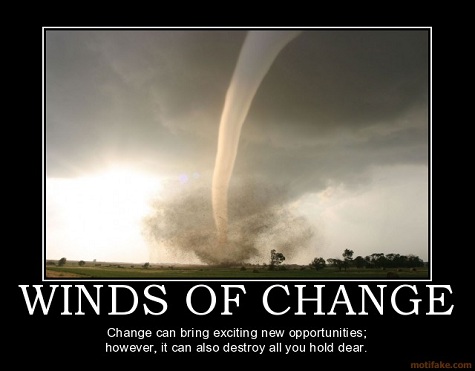Summary: Yesterday’s post The end of the post-WWII world is not the end of the world discussed the large-scale processes at work now. Today we discuss the most astonishing — and seldom seen — aspect of these things.
The problems of the many individual nations in crisis have received ample attention from experts. The two global dimensions of the crisis have not. First, the global financial regime no longer works well (as seen, for example, in the faltering ability of the US to act as the reserve currency, the disinterest of other nations in replacing the US in that role, and the wild gyrations of currency values). Second, the large number of nations experiencing large-scale structural change. Here we look at the second — and least well seen — aspect.

Contents
- The grand alignment of the nations
- Cause of the grand alignment
- A tour of the nations
- For more information
What caused the disaster of the Titanic? There was no single cause, it resulted from a constellation of simultaneous events. Bad weather. Bad luck. Mistakes. Lost gear. Errors of judgement.
Similarly today we have the major nations of the world simultaneously at or near (1 or 2 years?) major inflection points: Eurozone, UK, Japan, USA, and China. In each case largely due to internal dynamics, as their current internal economic systems fail and require major reforms. It’s the geopolitical version of the planetary grand alignment (which allowed NASA to send the Voyager One and Two probes to tour the solar system).
.
This creates danger and opportunity for each nation (as in the legend of the meaning of “crisis” in Chinese), but also the possibility of global synergy in a bad way over the short-term. As shown in yesterday’s post, even successful transitions are painful. Most or all of the major nations in transition would depress the global economy and lead to geopolitical instability.
What about the long-term? It could be very good, if everybody works their way through to successful new regimes. Or very bad, if most major nations fail to do so.

(2) Causes
The odds of this synchrony are too great for this to result from coincidence. What systemic factor might account for it? These nations have different demographics, economic and political structures, social systems, and trade patterns.
My guess (emphasis on guess): the common elements are poorly managed debt and lax regulation of their financial industry — although in different ways. Debt excesses differ from nation to nation: internal or external loans, private or public sector debt, debt incurred for investment or consumption. It’s the debt supercycle (coined by Hamilton Bolton and Tony Boeckh of Bank Credit Analyst).
Ditto for the banks. Some got into trouble speculating. Some the old fashioned way, by excessive and imprudent mortgage and business loans. Some were ordered or pressured by governments to make bad loans (often to the government).
But no matter what the path, the result was debt that could not be paid back and wrecked banks. There may be no other path to the future other than mass defaults and rebuilding many of the world’s banks (at somebody’s expense). The new world will probably build a fundamentally different global financial system than ours, learning from our generation-long experiment with debt. It’s a useful tool but, like many powerful tools (opiates, nuclear power, nailguns) becomes a fearsome thing when misused.

(3) A tour of the nations
(a) The Eurozone
The Eurozone is furthest along of the major nations in the cycle of crisis and resolution, and exhibits many of the traits only dimly visible elsewhere. It might also be the template that other nations follow to disaster: incorrect diagnosis of their problem, dogmatic adherence to unworkable solutions, reluctance to confront their core structural problems, and a refusal to learn from either economic theory or history.
Worse, Europe’s leaders appear unwilling to address their core problem. Perhaps because Europe’s people are not yet willing to do so. As we see in the Greek polls: 80% want to stay, 80% don’t want to pay the price of staying. Polls in Germany show a similar contradiction.
Francisco Blanch (Global Investment Strategist, Bank of America Merrill Lynch) explains the first three problems:
To begin with, it should be apparent by now that forcing consumers, corporates and governments to delever all at the same time is a painful policy. With consumers, corporates and governments in Peripheral Europe all rushing to sell assets, GDP has nose-dived in Spain, Italy, Greece or Portugal, to name a few. With GDP contracting at a faster rate than overall indebtedness in Peripheral Europe, debt to GDP ratios are not showing much improvement and borrowing costs are soaring, pushing some economies into a debt deflation spiral.In the New York Times of 20 May 2012 Paul Krugman explains the last of these problem, showing how today’s situation in the Eurozone is similar to that of the US-European situation at the end of WWI.
… As European deficit countries face a similar current account problem to that of the US but lack a flexible currency, continued debt rollovers are only perpetuating the problem. Meanwhile, Germany has instead shown a similar position to China several years ago (Chart 15). Quite strikingly, Germany’s foreign position has barely budged, making it nearly impossible for Peripheral countries to regain competitiveness. Put differently, the core is fast absorbing capital and labor, and exporting misery to the periphery. Germany is having its cake and eating it too, for now.
… Unfortunately, this situation is unlikely to persist. World history is littered with ruinous experiments linked to a lack of exchange rate and monetary policy flexibility (Chart 16). The gold standard in the Great Depression, the lost decade in Latin America, and the Asian Financial Crisis are good examples of how exchange rate distortions led to economic ruin. … But in the absence of currency, monetary and energy flexibility, the European sovereign debt crisis is far from over and about to start its most dangerous phase.
Read Keynes from Essays in Persuasion:The situation will eventually sort out. Despite the hysterical forecasts of doom, Europe will not sink forever like Atlantis. The process might be quick (these things tend to accelerate fast), but probably with much turmoil and pain. Here are some incisive recent articles about the Euro-crisis:
“Ultimately, and probably soon, there must be a readjustment of the balance of exports and imports. America must buy more and sell less. This is the only alternative to her making to Europe an annual present. Either American prices must rise faster than European (which will be the case if the Federal Reserve Board allows the gold influx to produce its natural consequences), or, failing this, the same result must be brought about by a further depreciation of the European exchanges, until Europe, by inability to buy, has reduced her purchases to articles of necessity.”He {Keynes} then goes on to discuss the folly of American policy, which simultaneously demanded that the Europeans pay in full while denying them the ability to export enough to make those payments. So here too we are repeating ancient mistakes. But why does nobody learn?
- “Tempting Rationale for Leaving the Euro“, New York Times, 15 May 2012
- “Greece’s predicament: Lessons from Argentina“, Peter Kretzmer and Mickey Levy, VOX, 16 May 2012
- “Greece Must Exit“, Nouriel Roubini, Roubini Global Economics, 18 May 2012
- “Europe’s Depressing Prospects: Two Reasons Why Spain Will Leave the Euro“, Michael Pettis, Roubini Global Economics, 18 May 2012
- “Today Germany Is the Big Loser, Not Greece“, Marshall Auerback, Naked Capitalism, 21 May 2012
Japan’s increasingly elderly majority have locked the nation into box of dyfunctional guaranteed to fail policies. Some experts believe their leaders have in effect given up on finding a solution, and just wait for the eventual singularity — wrecking the existing order and making possible a new Japan. The process probably will be painful. Here are two obituary notices:
- A bearish perspective on Japan by Hayman Capital Management, a Harvard Business School Case Study, 12 April 2012
- As Japan sails into the shadows, let’s wish them well and wave good-by, 14 July 2009
The UK now confronts decades of errors: over-reliance on North Sea oil (rapidly depleting), a poorly managed and over-size financial sector, and large public debt and liabilities. Worse, their leaders and people appear clueless about their problems and possible solutions. For details about this bleak situation see “Thinking the unthinkable – might there be no way out for Britain?“, Dr Tim Morgan (Global Head of Research), Tullett Prebon (UK brokerage firm), July 2011 (large pdf) — An excerpt looks at their future:
Our analysis indicates that the British economy, as currently aligned, is incapable of delivering growth at anywhere near the levels required by the deficit reduction agenda. In the decade prior to the financial crisis, the UK economy became hugely dependent upon debt. Taking public and private components together, debts have increased at an annual average rate of 11.2% of GDP since 2003. The two big drivers of the economy have been private (mortgage and credit) borrowing, and huge (and debt-dependent) increases in public spending.(d) China, India, and the US
Together, the severity of Britain’s indebtedness and the challenging outlook for the economy mean that the UK is now mired in a high-debt, low growth trap.
- Three of the UK’s 8 largest industries (real estate, financial services and construction), which account for 39% of the economy, are incapable of growth now that net private borrowing has evaporated.
- Another 3 of the top 8 sectors (health, education, and public administration and defence) account for a further 19%, and cannot expand now that growth in public spending is a thing of the past.
- This means that 58% of the economy is ex-growth, a figure that could rise to 70% if, as seems probable, growth in retailing is precluded by falling real consumer incomes. a very British mess
All these are in earlier stages of the crisis cycle which will test their people and leaders. Some will be in effect voted out of the major league nations; others will become regional hegemons or even perhaps superpowers in the next world order. For more about China and India see the FM Reference Page listing all posts by nation.
(4) For more information
See these FM Reference Pages for other posts about these topics:
